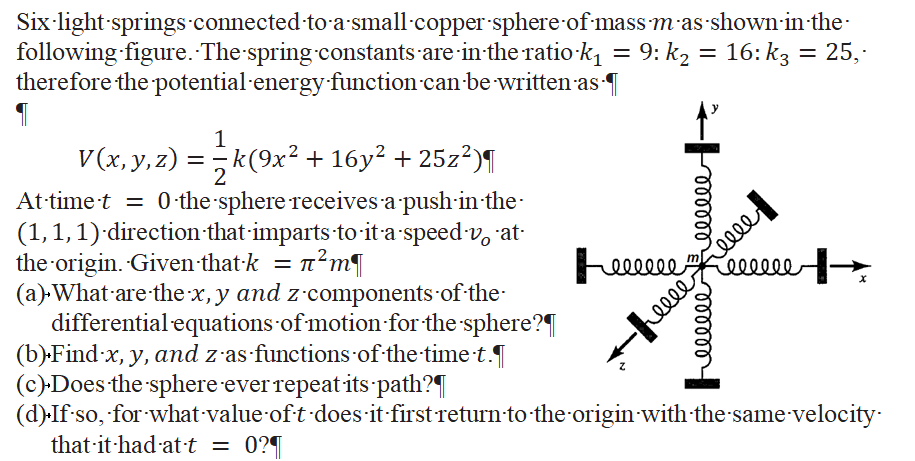Six-light-springs.connected to a small copper sphere-of mass m-as shown-in-the- following figure. The spring constants are in-the ratio-k = 9: k2 = 16: k3 = 25,· therefore the potential-energy function can-be written as T %D 1 V(x, y, z) = k(9x² + 16y² + 25z²)¶ At-timet = 0 the sphere receives a push-in the (1,1,1)'direction that-imparts to-it a speed v, at the origin. Given that-k = n?m¶ (a) What are-the x, y and z·components of the differential equations of motion for the sphere?| (b).Find x, y, and z as functions of the-time·t. (c)-Does the sphere everrepeat its path?¶ (d)-If so, for what value oft does it first return to the origin with the same velocity: that it had at·t = 0?¶ elleeeFeeel
Six-light-springs.connected to a small copper sphere-of mass m-as shown-in-the- following figure. The spring constants are in-the ratio-k = 9: k2 = 16: k3 = 25,· therefore the potential-energy function can-be written as T %D 1 V(x, y, z) = k(9x² + 16y² + 25z²)¶ At-timet = 0 the sphere receives a push-in the (1,1,1)'direction that-imparts to-it a speed v, at the origin. Given that-k = n?m¶ (a) What are-the x, y and z·components of the differential equations of motion for the sphere?| (b).Find x, y, and z as functions of the-time·t. (c)-Does the sphere everrepeat its path?¶ (d)-If so, for what value oft does it first return to the origin with the same velocity: that it had at·t = 0?¶ elleeeFeeel
Related questions
Question

Transcribed Image Text:Six-light-springs.connected to a small copper sphere-of mass m-as shown-in-the-
following figure. The spring constants are in-the ratio-k = 9: k2 = 16: k3 = 25,·
therefore the potential-energy function can-be written as T
%D
1
V(x, y, z) = k(9x² + 16y² + 25z²)¶
At-timet = 0 the sphere receives a push-in the
(1,1,1)'direction that-imparts to-it a speed v, at
the origin. Given that-k = n?m¶
(a) What are-the x, y and z·components of the
differential equations of motion for the sphere?|
(b).Find x, y, and z as functions of the-time·t.
(c)-Does the sphere everrepeat its path?¶
(d)-If so, for what value oft does it first return to the origin with the same velocity:
that it had at·t = 0?¶
elleeeFeeel
Expert Solution
Step by step
Solved in 9 steps with 9 images
